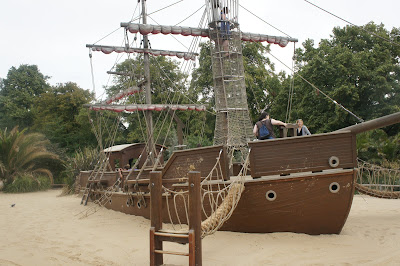Good to the last drop
Wednesday, August 10, 2011
More about Paris
Wednesday, August 03, 2011
Living like royalty
Tuesday, August 02, 2011


Park life



J'adore





An American in Paris
The British Library, at which I wonder if this is all but a dream
The Codex Sinaiticus (c. A.D. 350)
The oldest complete "Bible" in existence (along with one in the Vatican), this is one of the first attempts to collect various books together into one authoritative anthology. It's in Greek, the language in which most of the New Testament was written. The Old Testament portions are Greek translations from the original Hebrew. This particular Bible, and the nearby Codex Alexandrus (A.D. 425), contain some books not included in most modern English Bibles. (Even today Catholic Bibles contain books not found in Protestant Bibles.)
Scripture Fragments
These accounts of Jesus of Nazareth are about as old as any in existence, but some weren't written down until several generations after Jesus' death. Today, Bible scholars pore diligently over every word in the New Testament, trying to separate Jesus' authentic words from those that seem to have been added later.
Lindisfarne Gospels (A.D. 698) and Other Illuminated Manuscripts
Throughout the Middle Ages, Bibles had to be reproduced by hand. This was a painstaking process, usually done by monks for a rich patron. This beautifully illustrated ("illuminated") collection of the four Gospels is the most magnificent of medieval British monk-uscripts. The text is in Latin, the language of scholars ever since the Roman Empire, but the illustrations — with elaborate tracery and interwoven decoration — mix Irish, classical, and even Byzantine forms. (Read an electronic copy using the "Turning the Pages" computer.)
These Gospels are a reminder that Christianity almost didn't make it in Europe. After the fall of Rome (which had established Christianity as the official religion), much of Europe reverted to its pagan ways. This was the time of Beowulf, when people worshiped woodland spirits and terrible Teutonic gods. It took dedicated Irish missionaries 500 years to reestablish the faith on the Continent. Lindisfarne, an obscure monastery of Irish monks on an island off the east coast of England, was one of the few beacons of light after the fall of Rome, tending the embers of civilization through the long night of the Dark Ages.
The Gutenberg Bible (c. 1455)
It looks like just another monk-made Latin manuscript, but it was the first book printed in Europe using movable type. Printing is one of the most revolutionary inventions in history.
Johann Gutenberg (c. 1397-1468), a German silversmith, devised a convenient way to reproduce written materials quickly, neatly and cheaply — by printing with movable type. You scratch each letter onto a separate metal block, then arrange them into words, ink them up, and press them onto paper. When one job was done you could reuse the same letters for a new one.
This simple idea had immediate and revolutionary consequences. Suddenly, the Bible was available for anyone to read, fueling the Protestant Reformation. Knowledge became cheap and accessible to a wide audience, not just the rich. Books became the "mass media" of Europe, linking people by a common set of ideas.
Leonardo da Vinci's Notebook
Books also spread secular knowledge. Renaissance men turned their attention away from heaven and toward the nuts and bolts of the material world around them. These pages from Leonardo's notebook show his powerful curiosity, his genius for invention, and his famous backward and inside-out handwriting, which makes sense only if you know Italian and have a mirror. Leonardo's restless mind ranged from how birds fly to mechanics to military fortifications to the "earthshine" reflecting onto the moon to an early helicopter.
Beowulf (c. 1000)
Ponder this first English literary masterpiece. This Anglo-Saxon epic poem, written in Old English (the earliest version of our language), almost makes the hieroglyphics on the Rosetta Stone look easy. The manuscript is from A.D. 1000, although the story itself dates to about 750. In this epic story, the young hero Beowulf defeats two half-human monsters threatening the kingdom. Beowulf symbolizes England's emergence from the chaos and barbarism of the Dark Ages.
The Canterbury Tales (c. 1410)
Six hundred years later, England was Christian but it was hardly the pious, predictable, Sunday-school world we might imagine. Geoffrey Chaucer's bawdy collection of stories, told by pilgrims on their way to Canterbury, gives us the full range of life's experiences — happy, sad, silly, sexy, and devout. (Late in life, Chaucer wrote an apology for those works of his "that tend toward sin.")
While most serious literature of the time was written in scholarly Latin, the stories in The Canterbury Tales were written in Middle English, the language that developed after the French invasion (1066) added a Norman twist to Old English.
The Shakespeare First Folio (1623)
Shakespeare wrote his plays to be performed, not read. He published a few, but as his reputation grew, unauthorized "bootleg" versions began to circulate. Some of these were written by actors who were trying (with faulty memories) to re-create plays they had appeared in years before. Publishers also put out different versions of his plays.
It wasn't until seven years after his death that this complete collection of Shakespeare's plays was published. The editors were friends and fellow actors.
The engraving of Shakespeare on the title page is one of only two portraits done during his lifetime. Is this what he really looked like? No one knows. The best answer probably comes from Ben Jonson, in the introduction on the facing page. Jonson concludes, "Reader, look not on his picture, but his book."
References
Steves, Rick (n.d). The British Library: A self-guided tour. Retrieved from http://www.ricksteves.com/plan/destinations/britain/britlib.htm.
From London to Paris and back
Monday, August 01, 2011
